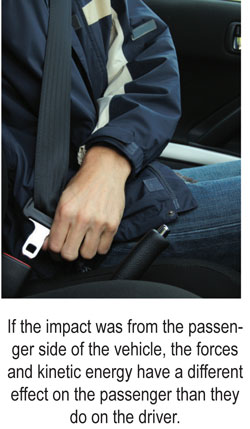Side or lateral impacts are the second most severe type of motor vehicle collision and have a very different effect on the body.
The forces transmitted from the bullet car to the target car are different from those of a frontal or rear collision. There are many different considerations to be aware of, but none is as unique as the near versus the far side occupant response. If the impact was from the passenger side of the vehicle, the forces and kinetic energy have a different effect on the passenger than they do on the driver. In a paper published in 2006 by Kumaresan, et al., at the Proceedings of the 28th IEEE EMBS Annual International Conference in New York City, NY, the authors tackled the issue of the effectiveness of the three point safety belt on the driver of a far side collision. The three point harness is the typical seat belt consisting of a lap belt and a diagonal shoulder harness. The authors state: “However, the lap/shoulder restraint is not effective in a far-side crash (impact is opposite to the occupant location) since the occupant may slip out of the shoulder harness.” (pg 87)

In fact, in a study done in 1991, “The study found that the AIS 2+ head injury was twice as much in far-side impacts compared to near-side crashes.” (pg 87) Further into this paper, the authors mention another study stating: “Diggs and Dalmatos also conducted vehicle to vehicle crash tests with 60 degree crash vectors and found that the shoulder belt was ineffective in preventing the head extrusions.” (pg 89) This study showed that the impact of the driver’s side occupant was to the passenger door panel. That should give you something to think about; I know it did for me. If you are not completely familiar with the AIS and MAIS injury scales, please email me directly and I will provide you with a FREE description of what the different levels represent in chart form from the Academy archives.
It is important to understand the basics of body kinematics in the frontal, rear and side impact crashes. This is beneficial to the clinician, as it allows us to focus our attention on the areas that are most commonly injured. When we are discussing these injuries in a medical-legal context, research is critical. Research allows us to compare our single crash victim to an entire cohort involved in a research study. This puts the causality portion of the injury in perspective and allows us to concentrate on correlating the traumatic event to the bodily injury and, then, to the patient’s functional losses. Side impacts are a different animal and they have to be treated as such. Specific examinations, such as brainstem evaluations, cranial nerve examinations and advanced imaging procedures, may be more commonly used since the possibility of head trauma in a far sided lateral impact is twice that of other vectors. Being familiar with research not only increases your credibility as a patient advocate, it also allows you to look a patient in the eye and honestly say, “You are not alone.”
 In each issue, a clinical topic will be covered by Dr. William J. Owens of the American Academy of Medical Legal Professionals (AAMLP), which is a national, non-profit organization, comprised of doctors and lawyers. The purpose of the organization is to provide its members with current research in trauma and spinal related topics, to keep the profession on the cutting edge of healthcare. Members may also sit for a Diplomate examination and be conferred a DAAMLP. The organization also offers support to the individual member’s practice. To learn more, go to www.aamlp.org or call 1-716-228-3847.
In each issue, a clinical topic will be covered by Dr. William J. Owens of the American Academy of Medical Legal Professionals (AAMLP), which is a national, non-profit organization, comprised of doctors and lawyers. The purpose of the organization is to provide its members with current research in trauma and spinal related topics, to keep the profession on the cutting edge of healthcare. Members may also sit for a Diplomate examination and be conferred a DAAMLP. The organization also offers support to the individual member’s practice. To learn more, go to www.aamlp.org or call 1-716-228-3847.
